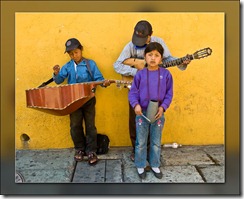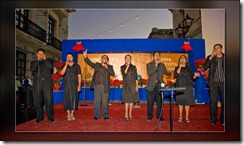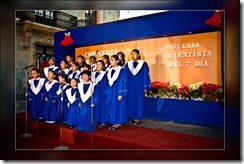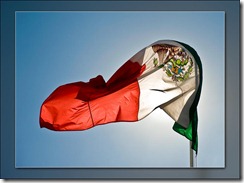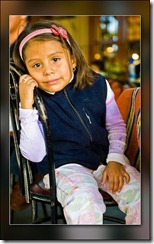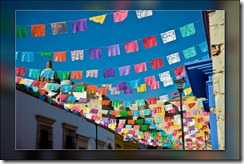 I’m not usually much of a shopper, but in this case I wanted the best deal, so I did a fair amount of walking. I’m skeptical of prices that seem too good to be true, but the outfit looked respectable and the gal behind the desk was cute. So, I bought the ticket that would take me out of Central America to my home continent (I paid $40 instead of $60).
I’m not usually much of a shopper, but in this case I wanted the best deal, so I did a fair amount of walking. I’m skeptical of prices that seem too good to be true, but the outfit looked respectable and the gal behind the desk was cute. So, I bought the ticket that would take me out of Central America to my home continent (I paid $40 instead of $60).
The ride from Antigua, Guatemala into Mexico to San Cristóbol de las Casas would take the better part of a day, but with a good van, the best driver of my entire trip, a  nice family from Mexico city, and an Angelina Jolie lookalike from France, my surroundings and situation could have been far worse.
nice family from Mexico city, and an Angelina Jolie lookalike from France, my surroundings and situation could have been far worse.
On the downside, I did feel kind of sick for quite some time as the roads leading northward in this part of Guatemala to the Mexican border were as crooked as a dog’s hind leg. There was also tons of roadwork going on in Guatemala—and speed bumps. I had never seen so many speed bumps, both in Guatemala and Mexico.
 As we left the lush, leafy, greenness of Central America, the landscape turned dry and rocky, dominated by pine trees.
As we left the lush, leafy, greenness of Central America, the landscape turned dry and rocky, dominated by pine trees.
As with many border crossings, the town of La Mesilla was hopping. I would have liked to have spent some time wandering around there, but we were stopped simply to get our passports stamped and to connect with another van. Maybe next time.
Once we got into Mexico, I was impressed with the highway. Reminded me a bit of home. Better than many roads I had seen on my trip. More speed bumps.
Part way to San Cristóbol, we pulled off to get some food. It was a nice restaurant and I was hungry. The food wasn’t spicy at all. In fact, it was rather bland. This was  the beginning of a discovery for me. Throughout my time in Mexico, I would find that the food got spicier the farther north I went, and that the less I paid for a meal, the better I liked the food—and not just because I’m a cheapskate!
the beginning of a discovery for me. Throughout my time in Mexico, I would find that the food got spicier the farther north I went, and that the less I paid for a meal, the better I liked the food—and not just because I’m a cheapskate!
We arrived in San Cristóbol just in time for Iana (the French Angelina Jolie) to catch her bus back to Mexico City. She had been in an exchange program for the past 6 months and had 2 days left in Mexico before returning home. After that, the bus dropped off the Mexican family of 4 at their hotel. They were reasonably well off. They stayed at a nice hotel, and whenever we  ate together, it was at a somewhat pricey restaurant. I was last on the itinerary. The driver dropped me off at the hostel. I gave him a generous tip and told him he had been the best driver of my trip.
ate together, it was at a somewhat pricey restaurant. I was last on the itinerary. The driver dropped me off at the hostel. I gave him a generous tip and told him he had been the best driver of my trip.
After entering the hostel, I was informed they were full. The nice lady called another hostel, however, and was told they had a room. So, with backpack, camera bag, small guitar from Salta, Argentina, and a couple bags of things I had bought in Guatemala in hand, I marched the 8 blocks in the dark to hostal numero dos. I had to stop for rest along the way, but I finally made it.
The family from Mexico City—Vicente (dad), Tere (mom), Vicente Jr. (son), and Renata (daughter)—was going to swing by my hostel the next morning so we could spend the day together. The only problem was that I was in a different hostel than I had told them I would be in and they  would never find me. Despite my horrendous memory, I remembered where they were staying and I caught them in the lobby as they were heading out to drop off their laundry. After the laundromat, we went to a nice restaurant for breakfast. Following that, we spent all day bumming around the area together.
would never find me. Despite my horrendous memory, I remembered where they were staying and I caught them in the lobby as they were heading out to drop off their laundry. After the laundromat, we went to a nice restaurant for breakfast. Following that, we spent all day bumming around the area together.
San Cristóbol de las Casas is a city only slightly smaller than my hometown of Tacoma, with a population of just over 140,000.  It sits much, higher, though, at almost 7,000 feet. It was named after a Spanish priest who actually defended the rights of the natives rather than slaughtering them—a pleasant bit of history unlike much of Latin America’s tumultuous past. Nice to have someone stick up for you when most folks just want to kick your ass and take your stuff. And of course, most of the inhabitants are Catholic, with a mix of indigenous beliefs thrown in for good measure.
It sits much, higher, though, at almost 7,000 feet. It was named after a Spanish priest who actually defended the rights of the natives rather than slaughtering them—a pleasant bit of history unlike much of Latin America’s tumultuous past. Nice to have someone stick up for you when most folks just want to kick your ass and take your stuff. And of course, most of the inhabitants are Catholic, with a mix of indigenous beliefs thrown in for good measure.
Besides bumming around San Cristóbol de las Casas for several hours, we traveled in a minivan to a small town a few miles away called San Juan Chamula. It has only a few thousand inhabitants who live around the perimeter of the town and on farms outside the town. In the center of the town is a large plaza which hosts a daily market and a church with its own grand plaza,  complete with gazebo. When we were there, some kind of ritual was going on with tree branches scattered around the perimeter of the church’s plaza. They were preparing to walk that perimeter and weren’t allowing photos. Also, cameras weren’t allowed in the church. I bought a few tangerines and clay figures in the market. We weren’t there long, but it was worth the jaunt. We crammed into a taxi for the ride back to home base and split the fare. The driver stopped on the way for me to shoot a few photos overlooking the town.
complete with gazebo. When we were there, some kind of ritual was going on with tree branches scattered around the perimeter of the church’s plaza. They were preparing to walk that perimeter and weren’t allowing photos. Also, cameras weren’t allowed in the church. I bought a few tangerines and clay figures in the market. We weren’t there long, but it was worth the jaunt. We crammed into a taxi for the ride back to home base and split the fare. The driver stopped on the way for me to shoot a few photos overlooking the town.
 Something that cracked me up in Mexico was the lights in churches—fluorescent lights as the primary light source (very cold, dark, and dreary), light bulbs standing in for candles, and strips of neon framing a painting of Jesus. Hilarious.
Something that cracked me up in Mexico was the lights in churches—fluorescent lights as the primary light source (very cold, dark, and dreary), light bulbs standing in for candles, and strips of neon framing a painting of Jesus. Hilarious.
After getting back from San Juan Chamula, my friends went to their hotel to clean up and I went back to my hostel to put on warmer clothes. We were to meet in the plaza to go out to dinner together and I showed up about an hour early. I saw many young girls—probably 6 years old and up—selling blankets, necklaces, and other things tourists might want to purchase. They wore sandals, had filthy feet, and the weather was getting colder and colder as the sun went down. Apparently, there aren’t any child labor laws in Mexico. I felt sorry for these little girls.
 That night, we went out to a nice—and expensive—restaurant with live music, first two fellas playing a marimba, then a man and woman playing classical guitars and singing. After that, we went to a small but popular coffee shop where they were roasting their own coffee. After that, I exchanged hugs with my new Mexican friends and we parted ways. They invited me to stay with them if I ever visit Mexico City. Although I enjoyed San Cristóbol de las Casas and San Juan Chamula, the highlight of my visit was spending time with my new Mexican friends.
That night, we went out to a nice—and expensive—restaurant with live music, first two fellas playing a marimba, then a man and woman playing classical guitars and singing. After that, we went to a small but popular coffee shop where they were roasting their own coffee. After that, I exchanged hugs with my new Mexican friends and we parted ways. They invited me to stay with them if I ever visit Mexico City. Although I enjoyed San Cristóbol de las Casas and San Juan Chamula, the highlight of my visit was spending time with my new Mexican friends.
Next on the itinerary? Oaxaca for a day, then Christmas with my friends Tim and Barbara-Lee Glessner in Puebla, Mexico.














